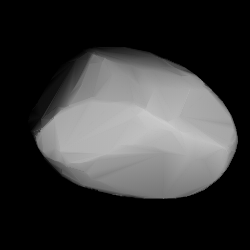ネッカー (小惑星)
この項目「ネッカー (小惑星)」は翻訳されたばかりのものです。不自然あるいは曖昧な表現などが含まれる可能性があり、このままでは読みづらいかもしれません。(原文:1223 Neckar (20:22, 11 December 2021)) 修正、加筆に協力し、現在の表現をより自然な表現にして下さる方を求めています。ノートページや履歴も参照してください。(2022年10月) |
ネッカー(1223 Neckar)は、小惑星帯外側の領域に存在する岩石質のコロニス族の小惑星である。直径は、約25 kmである。1931年にケーニッヒシュトゥール天文台で、カール・ラインムートが発見し、ドイツにあるネッカー川に因んで命名された。S型小惑星で、自転周期は7.8時間である[3]。
| ネッカー 1223 Neckar | |
|---|---|
| 仮符号・別名 | 1931 TG · 1930 MN 1931 TA1 · 1953 FC A907 VD · A909 BD A917 XC · A917 YA |
| 分類 | 小惑星 |
| 軌道の種類 | 小惑星帯[1][2](コロニス族[3][4][5][6]) |
| 発見 | |
| 発見日 | 1931年10月6日[1] |
| 発見者 | カール・ラインムート[1] |
| 軌道要素と性質 元期:2018年3月23日 (JD 2,458,200.5)[2] | |
| 軌道長半径 (a) | 2.8686 AU |
| 近日点距離 (q) | 2.6977 AU |
| 遠日点距離 (Q) | 3.0395 AU |
| 離心率 (e) | 0.0596 |
| 公転周期 (P) | 4.86 年(1,775 日) |
| 軌道傾斜角 (i) | 2.5448 度 |
| 近日点引数 (ω) | 15.444 度 |
| 昇交点黄経 (Ω) | 40.812 度 |
| 平均近点角 (M) | 235.10 度 |
| 物理的性質 | |
| 直径 | 22.783±0.213 km[7] 23.06±0.56 km[8] 24.68±0.55 km[9] 25.736±0.261 km[10] 26.07±0.86 km[11] 27.96 km (derived)[3] |
| 自転周期 | 7.763 h[12] 7.80±0.06 h[13] 7.81 h[5] 7.82124 h[6] 7.82401±0.00005 h[14] 7.827±0.0036 h[15] 8.78 h (wrong)[16] |
| スペクトル分類 | Tholen = S[2][3] · S[17] B?V = 0.840[2] U?B = 0.405[2] |
| アルベド(反射能) | 0.123[18] 0.1461±0.0271[10] 0.152±0.025[11] 0.170±0.012[9] 0.201±0.011[8] |
| ■Template (■ノート ■解説) ■Project | |

発見 編集
ネッカーは、1931年10月6日にドイツの天文学者カール・ラインムートにより、ドイツ南西部にあるケーニッヒシュトゥール天文台で発見された[1]。その5日後、ユックルにあるベルギー王立天文台でフェルナン・リゴーが独立に発見したが[19]、小惑星センターは、前者の発見のみを認めている[1]。この小惑星は、1907年11月には、ケーニッヒシュトゥール天文台で、A907 VDとして観測されていたため、w:observation arcは、公式な発見よりも24年間延長された[1]。
軌道と分類 編集
ネッカーは、ほぼ共平面の楕円軌道を持ち、外小惑星帯の非常に大きな小惑星族であるコロニス族を構成する主要な小惑星の1つである[4]。コロニスに因んで名づけられたこの小惑星族は、少なくとも20億年前に、2つの大きな天体の破局的衝突により形成されたと考えられている。小惑星帯外側のカークウッドの空隙付近となる太陽から2,7-3.0天文単位の軌道を4年10か月(1775日)かけて公転している。軌道離心率は0.06、軌道傾斜角は黄道面に対して3°である[2]。
物理的性質 編集
トーレンの分類では、ネッカーは、一般的な岩石質のS型小惑星に分類される[2]。また、パンスターズでもS型に分類されている[17]。
自転周期 編集
光学曲線からは、自転周期は7.763及び7.81時間、光度の振れ幅は0.18及び0.45等級となる[5][12]。しかし、リチャード・ビンゼルとエド・テデスコが1970年代から1980年代に行った測光観測ではより長い周期が示され、現在ではこれは誤りと考えられている[3][16]。
2010年と2014年に行われたw:Palomar Transient Factoryでは、7.80及び7.8273時間の自転周期を示すR帯の2つの光学曲線が得られた[13][15]。スピン軸は何度か決定され、最も信頼性の高い結果は、ポーランドの天文学者が率いるグループが実施したもので、黄道座標上の2つの極(70.0°, 45.0°)と(225.0°, 42.0°)が得られた[12]。
直径とアルベド 編集
あかりや広域赤外線探査衛星及びその後継のNEOWISEによる観測で、各々、ネッカーの直径は22.783及び26.07 km、表面のアルベドは0.146及び0.201と測定された[7][8][9][10][11]。Collaborative Asteroid Lightcurve Linkは、Morrisonが1970年代に得た0.123というアルベドを採用し[18]、絶対等級10.66から、直径を27.96 kmとしている[3]。
命名 編集
ドイツ南西部を流れ、特に発見地であるハイデルベルクを通るネッカー川に因んで名づけられた。この川は、シュヴァルツヴァルトを源流とし、ライン川に合流する。ポール・ハーゲットの1955年の著作The Names of the Minor Planetsで初めて公表された[19]。
出典 編集
- ^ a b c d e f “1223 Neckar (1931 TG)”. Minor Planet Center. 2018年5月3日閲覧。
- ^ a b c d e f g “JPL Small-Body Database Browser: 1223 Neckar (1931 TG)”. Jet Propulsion Laboratory. 2018年5月3日閲覧。
- ^ a b c d e f “LCDB Data for (1223) Neckar”. Asteroid Lightcurve Database (LCDB). 2018年5月3日閲覧。
- ^ a b “Asteroid 1223 Neckar ? Nesvorny HCM Asteroid Families V3.0”. Small Bodies Data Ferret. 2019年10月26日閲覧。
- ^ a b c Slivan, Stephen M.; Binzel, Richard P. (December 1996). “Forty-eight New Rotation Lightcurves of 12 Koronis Family Asteroids”. Icarus 124 (2): 452?470. Bibcode: 1996Icar..124..452S. doi:10.1006/icar.1996.0222.
- ^ a b Slivan, Stephen M.; Binzel, Richard P.; Crespo da Silva, Lucy D.; Kaasalainen, Mikko; Lyndaker, Mariah M.; Krco, Marko (April 2003). “Spin vectors in the Koronis family: comprehensive results from two independent analyses of 213 rotation lightcurves”. Icarus 162 (2): 285?307. Bibcode: 2003Icar..162..285S. doi:10.1016/S0019-1035(03)00029-0.
- ^ a b Masiero, Joseph R.; Grav, T.; Mainzer, A. K.; Nugent, C. R.; Bauer, J. M.; Stevenson, R. et al. (August 2014). “Main-belt Asteroids with WISE/NEOWISE: Near-infrared Albedos”. The Astrophysical Journal 791 (2): 11. arXiv:1406.6645. Bibcode: 2014ApJ...791..121M. doi:10.1088/0004-637X/791/2/121.
- ^ a b c Usui, Fumihiko; Kuroda, Daisuke; Muller, Thomas G.; Hasegawa, Sunao; Ishiguro, Masateru; Ootsubo, Takafumi et al. (October 2011). “Asteroid Catalog Using Akari: AKARI/IRC Mid-Infrared Asteroid Survey”. Publications of the Astronomical Society of Japan 63 (5): 1117?1138. Bibcode: 2011PASJ...63.1117U. doi:10.1093/pasj/63.5.1117. (online, 臼井文彦『Mid-Infrared Asteroid Survey with AKARI / 「あかり」衛星による小惑星の中間赤外線サーベイ』 東京大学 博士論文〈乙第17829号〉、2013年、153(p.1-178)頁。doi:10.15083/00007191。 NAID 500000941211。)
- ^ a b c Masiero, Joseph R.; Mainzer, A. K.; Grav, T.; Bauer, J. M.; Cutri, R. M.; Nugent, C. et al. (November 2012). “Preliminary Analysis of WISE/NEOWISE 3-Band Cryogenic and Post-cryogenic Observations of Main Belt Asteroids”. The Astrophysical Journal Letters 759 (1): 5. arXiv:1209.5794. Bibcode: 2012ApJ...759L...8M. doi:10.1088/2041-8205/759/1/L8.
- ^ a b c Mainzer, A.; Grav, T.; Masiero, J.; Hand, E.; Bauer, J.; Tholen, D. et al. (November 2011). “NEOWISE Studies of Spectrophotometrically Classified Asteroids: Preliminary Results”. The Astrophysical Journal 741 (2): 25. arXiv:1109.6407. Bibcode: 2011ApJ...741...90M. doi:10.1088/0004-637X/741/2/90. (catalog)
- ^ a b c Hasegawa, Sunao; Muller, Thomas G.; Kuroda, Daisuke; Takita, Satoshi; Usui, Fumihiko (April 2013). “The Asteroid Catalog Using AKARI IRC Slow-Scan Observations”. Publications of the Astronomical Society of Japan 65 (2): 11. arXiv:1210.7557. Bibcode: 2013PASJ...65...34H. doi:10.1093/pasj/65.2.34.
- ^ a b c Michalowski, T.; Pych, W.; Berthier, J.; Kryszczynska, A.; Kwiatkowski, T.; Boussuge, J. et al. (November 2000). “CCD photometry, spin and shape models of five asteroids: 225, 360, 416, 516, and 1223”. Astronomy and Astrophysics Supplement 146 (3): 471?479. Bibcode: 2000A&AS..146..471M. doi:10.1051/aas:2000282.
- ^ a b Chang, Chan-Kao; Lin, Hsing-Wen; Ip, Wing-Huen; Prince, Thomas A.; Kulkarni, Shrinivas R.; Levitan, David et al. (December 2016). “Large Super-fast Rotator Hunting Using the Intermediate Palomar Transient Factory”. The Astrophysical Journal Supplement Series 227 (2): 13. arXiv:1608.07910. Bibcode: 2016ApJS..227...20C. doi:10.3847/0067-0049/227/2/20.
- ^ Hanus, J.; Durech, J.; Broz, M.; Warner, B. D.; Pilcher, F.; Stephens, R. et al. (June 2011). “A study of asteroid pole-latitude distribution based on an extended set of shape models derived by the lightcurve inversion method”. Astronomy & Astrophysics 530: 16. arXiv:1104.4114. Bibcode: 2011A&A...530A.134H. doi:10.1051/0004-6361/201116738.
- ^ a b Waszczak, Adam; Chang, Chan-Kao; Ofek, Eran O.; Laher, Russ; Masci, Frank; Levitan, David et al. (September 2015). “Asteroid Light Curves from the Palomar Transient Factory Survey: Rotation Periods and Phase Functions from Sparse Photometry”. The Astronomical Journal 150 (3): 35. arXiv:1504.04041. Bibcode: 2015AJ....150...75W. doi:10.1088/0004-6256/150/3/75.
- ^ a b Binzel, R. P. (October 1987). “A photoelectric survey of 130 asteroids”. Icarus 72 (1): 135?208. Bibcode: 1987Icar...72..135B. doi:10.1016/0019-1035(87)90125-4. ISSN 0019-1035.
- ^ a b Veres, Peter; Jedicke, Robert; Fitzsimmons, Alan; Denneau, Larry; Granvik, Mikael; Bolin, Bryce et al. (November 2015). “Absolute magnitudes and slope parameters for 250,000 asteroids observed by Pan-STARRS PS1 - Preliminary results”. Icarus 261: 34?47. arXiv:1506.00762. Bibcode: 2015Icar..261...34V. doi:10.1016/j.icarus.2015.08.007.
- ^ a b Morrison, D.; Zellner, B. (December 1978). “Polarimetry and radiometry of the asteroids”. In: Asteroids. (A80-24551 08-91) Tucson: 1090?1097. Bibcode: 1979aste.book.1090M.
- ^ a b Schmadel, Lutz D. (2007). “(1223) Neckar”. Dictionary of Minor Planet Names ? (1223) Neckar. Springer Berlin Heidelberg. p. 102. doi:10.1007/978-3-540-29925-7_1224. ISBN 978-3-540-00238-3
外部リンク 編集
- Asteroid Lightcurve Database (LCDB), query form (info Archived 16 December 2017 at the Wayback Machine.)
- Dictionary of Minor Planet Names, Google books
- Asteroids and comets rotation curves, CdR ? Observatoire de Geneve, Raoul Behrend
- Discovery Circumstances: Numbered Minor Planets (1)-(5000) - Minor Planet Center
- ネッカー - JPL Small-Body Database